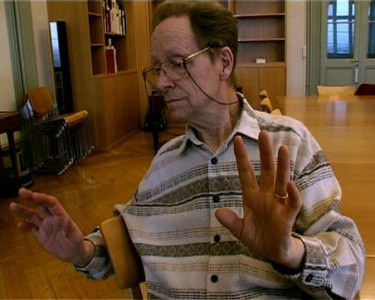L’AGP rilancia un vecchio vinile che contiene i risultati di un esperimento realizzato durante l’edizione del 1967 dei corsi estivi tenuti da Stockhausen a Darmstadt (il disco è stato poi realizzato nel 1971).
12 compositori sono stati invitati a scrivere dei brani per strumento solista e nastro o trasmettitore a onde corte (1 solo esecutore), tali da poter essere eseguiti simultaneamente. Per soddisfare questa condizione, i pezzi non dovevano essere dei prodotti finiti, bensì una collezione di interventi sonori suscettibili di dilatazioni e/o spostamenti temporali.
L’elenco di strumenti, compositori ed esecutori è:
| Instrument |
Composer |
Musician |
| Flute |
Tomas Marco |
Ladislav Soka |
| Oboe |
Avo Somer |
Milan Jezo |
| Clarinet |
Nicolaus A.Huber |
Juraj Bures |
| Basoon |
Robert Wittinger |
Jan Martanovic |
| French horn |
John McGuire |
Jozef Svenk |
| Trumpet |
Peter R.Farmer |
Vladimir Jurca |
| Trombone |
Gregory Biss |
Frantisek Hudecek |
| Violin |
Jurgen Beurle |
Viliam Farkas |
| Violoncello |
Mesias Maiguashca |
Frantisek Tannenberger |
| Double Bass |
Jorge Peixinho |
Karol Illek |
| Percussion |
Rolf Gelhaar |
Frantisek Rek |
| Hammond Organ |
Johannes G.Fritsch |
Aloys Kontarsky |
Gli esecutori sono stati poi divisi a gruppi di 2/3 i cui output venivano inviati a uno di quattro mixer ciascuno collegato a 2 altoparlanti. A un ulteriore, solitario altoparlante è collagato l’organo hammond. Ne risulta quindi uno spazio sonoro a 9 altoparlanti in cui viene diffuso simultaneamente l’insieme di tutti brani, secondo lo schema seguente:

La direzione dell’esecuzione è dello stesso Stockhausen. L’album, ormai fuori catalogo, contiene una riduzione effettuata da Stockhausen di una performance di circa 4 ore.
Potete scaricare il tutto in flac da AGP98.
ENSEMBLE is an experiment in adding a new concept to the traditional “concert”. We are used to comparing different pieces played sequentially. In ENSEMBLE “pieces” of 12 composers are played simultaneously.
These “pieces” are musical objects (“works”) not fully worked out. They are sound objects (produced on tape or with a short wave transmitter), with individual control, action and reaction models, and notated “events”, which are introduced by the composers to the ENSEMBLE play in the process of the actual performance.
Each composer has composed for one musician and tape or short wave transmitter. The total plan and the introduction of the parts for its synchronisation with the ENSEMBLE were established by Stockhausen. The twelve systems and their coordination were formulated during daily meetings. The resulting four hour process is more than the addition of the “pieces”: it is a composition of compositions, fluctuating between the complete isolation of the different events and the total dependence of each layer, and between extreme determinism and full improvisation.
On top of the 12 composers and musicians, who play together as “duos” – distributed throughout the room – four other musicians are responsible for using mixers to amplify and spacialize definite details and moments of the process via microphones and eight loudspeakers. Also, the position of the listener is not fixed. He can move in the room and thus establish his acoustical perspective.
The simultaneity of the compositions requires also that certain “pieces” should be heard together and related through superimposition.
This “verticalisation” of the perception of events and the relativisation of a definitive form (“piece” signed by an individual) happens not only in the field of music. — Notes by Karlheinz Stockhausen
Darmstadt International Music Institute
22nd International Seminar for New Music 1967, director Ernst Thomas
The LP version of “Ensemble” was realized in the WDR Electronic Music Studio between August 26 and September 22, 1971. The available material was:
– Recording of the rehearsal on August 28, 1967 from 19:00-23:00 (6 stereo tapes, about 4 hours duration)
– Recording of the concert on August 29, 1967 from 19:00-23:00 (6 stereo tapes, about 4 hours duration)
The challenge for me was to reduce a four-hour performance to 50-60 minutes, and therefore I proceeded as follows.
1. I wanted as much as possible to keep the formal pattern that we had developed during the Seminar
2. I wanted to keep a balance between the deterministic, less deterministic and non-deterministic material.
My working method was as follows:
1. I listened to all tapes of both recordings. The material that seemed to me adequate, I copied.
2. This selected material was listened to again, cutting out some sections, so that a series of musical events remained, which I deemed relevant.
3. In the third process – the most difficult one – this material was cut, faded in and out and mixed occasionally according to my vision (retaining the time plan in its basic structure)
Notes by Mesias Maiguashca
 Continuo’s weblog recupera una bella incisione Wergo del 1985, ormai fuori catalogo, dedicata alle sculture sonore.
Continuo’s weblog recupera una bella incisione Wergo del 1985, ormai fuori catalogo, dedicata alle sculture sonore.

